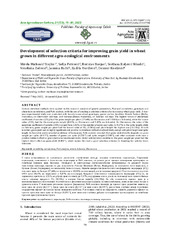Приказ основних података о документу
Development of selection criteria for improving grain yield in wheat grown in different agro-ecological environments
| dc.creator | Matkovic Stojsin, Mirela | |
| dc.creator | Petrović, Sofija | |
| dc.creator | Banjac, Borislav | |
| dc.creator | Roljević Nikolić, Svetlana | |
| dc.creator | Zečević, Veselinka | |
| dc.creator | Bačić, Jasmina | |
| dc.creator | Đorđević, Radiša | |
| dc.creator | Knežević, Desimir | |
| dc.date.accessioned | 2024-03-19T18:48:56Z | |
| dc.date.available | 2024-03-19T18:48:56Z | |
| dc.date.issued | 2022 | |
| dc.identifier.issn | 0354-9542 | |
| dc.identifier.uri | https://intam.institut-tamis.rs/handle/123456789/234 | |
| dc.identifier.uri | https://enauka.gov.rs/handle/123456789/561151 | |
| dc.identifier.uri | http://RIVeC.institut-palanka.rs/handle/123456789/497 | |
| dc.identifier.uri | https://plantarum.izbis.bg.ac.rs/handle/123456789/1230 | |
| dc.description.abstract | Various statistical methods were applied in this research: analysis of genetic parameters, Pearson’s correlation, genotypic and phenotypic correlations, and Path analysis, with the aim of creating a selection criterion for increasing wheat grain yield. A twoyear experimental study was conducted with twenty-seven wheat genotypes, grown on two localities: Rimski Šančevi (Bačka, Vojvodina), on Chernozem soil type; and Kumane (Banat, Vojvodina), on Solonjec soil type. The highest values of phenotypic coefficient of variation (CVp) had the grain weight per plant (17.44% on Chernozem and 13.81% on Solonetz), while the lowest value of CVp had the thousand grain weight (8.12% on Chernozem and 5.47% on Solonetz). On Chernozem, the value of the genotypic coefficient of variation (CVg) ranged from 1.51%, in the number of grains per spike, to 9.17% in the spike length, while on Solonetz, grain weight per plant had the lowest value of CVg (0.36%) and plant height the highest one (11.15%). At both localities, grain yield was in highly significant and positive correlations with all analyzed traits, except with plant height and spike length. In favorable environmental conditions (Chernozem), Path analysis revealed that grain yield directly depends on grain weight per spike (0.317**), number of grains per spike (0.232**) and spike weight (0.209**), and other analyzed traits have a positive indirect effect on grain yield over mentioned traits. Under salinity stress conditions, the grain weight per plant had the highest direct effect on grain yield (0.891**), which makes this trait a good selection criterion in breeding for salinity stress tolerance. | sr |
| dc.language.iso | en | sr |
| dc.publisher | Čačak : Poljoprivredni fakultet, Univerzitet u Kragujevcu | sr |
| dc.relation | info:eu-repo/grantAgreement/MESTD/Technological Development (TD or TR)/31092/RS// | sr |
| dc.relation | info:eu-repo/grantAgreement/MESTD/inst-2020/200189/RS// | sr |
| dc.relation | info:eu-repo/grantAgreement/MESTD/inst-2020/200216/RS// | sr |
| dc.rights | openAccess | sr |
| dc.rights.uri | https://creativecommons.org/licenses/by/4.0/ | |
| dc.source | Acta Agriculturae Serbica | sr |
| dc.subject | variability | sr |
| dc.subject | correlations | sr |
| dc.subject | Path analysis | sr |
| dc.subject | wheat | sr |
| dc.subject | Solonetz | sr |
| dc.subject | Chernozem | sr |
| dc.title | Development of selection criteria for improving grain yield in wheat grown in different agro-ecological environments | sr |
| dc.type | article | sr |
| dc.rights.license | BY | sr |
| dc.citation.epage | 87 | |
| dc.citation.issue | 53 | |
| dc.citation.spage | 79 | |
| dc.citation.volume | 27 | |
| dc.type.version | publishedVersion | sr |
| dc.identifier.doi | 10.5937/AASer2253079M | |
| dc.identifier.fulltext | http://plantarum.izbis.bg.ac.rs/bitstream/id/3801/bitstream_1655.pdf |


